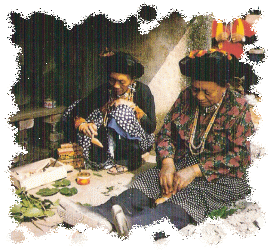 |
 |
Current position:Five Years Glory > Essential Rites of Sacrificial Ceremonies |
--- Five Years Glory --- |
| The Origin of Five-Year Fiesta |
| Preparation before Five-Year Fiesta |
| Sacrificial Ceremony Staffs |
| Utensils for the Ceremony |
| Essential Rites of Sacrificial Ceremonies |
| The Process of Five-Year Fiesta |
| Songs |
| Essential Rites of Sacrificial Ceremonies |
Essential Rites of Sacrificial Ceremonies |
|
The high priest takes fiesta tray with both hands and puts on the ground to indicate beginning of the ceremony. |
|
|
1. Prepare mulberry leaves or banyan leaves. Cut both ends to become a fiesta leaf. Three leaves as a pile. 2.Moisten the pig bone pieces by exhaling the first time to pare pig bone and put on the leaves. It tells the ancestor that we use the most solemn ceremony to offer sacrifice. 3. The high priest pares pig backbone pieces on leaves to use as sacrifice and then reports to ancestor deity the content of sacrifice. If the sacrificial offering was to be sent to other places, it should include skull, one piece of spine or rib bones, a right front shank bone and the phalange (toe bone) to become a big sacrifice. 4. Take the sacrifice (10 parts for chief's home; 5 parts for civilian), fiesta knife, and fiesta cup with water in it to outdoors on the west direction of the residence or downstream; and put them on the ground to offer a sacrificial ceremony. The process includes clearing the road and exorcism, which mean to throw out bad things. To dip the fiesta knife in water means to purify and ward off evils.
|
Image: The process of the rites held by the high priest. |
5.When finishing chanting the scriptures, the high priest takes the sacrifice, knife and backbone outdoors on the east side or to a place closest to the top of the house. The sacrificial offerings are put on the windowsill, a small niche hole above the window or on the rooftop; and to offer pig backbone to deity. Coming back indoors, make another portion of sacrifice called taviyangan and put in fiesta tray after exhaling to symbolize that we keep all the things we prayed for and blessed here at home. Afterwards, put back the fiesta tray to the original place and finish the ceremony.
|
|
Source: Paiwan Tribe - Picture Book of Gulou Village Image: Paiwan Tribe - Picture Book of Gulou Village Edited by: Hui-hsin Gao, Yi-de Chou |
|
Planned by volunteer teachers at Kuljaljau Elementary School, Laiyi Township Pingtung County, Year 2007; Made by Goblin’s Aspirational Team.
To view the contents on this website, a computer monitor with 1024x768 dpi and an Internet browser of Microsoft Internet Explorer 5.5 or above is recommended.
